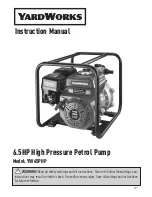
5 — English
Do not drive fasteners near edge of material.
The
workpiece may split causing the fastener to ricochet,
injuring you or a co-worker. Be aware that the fastener
may follow the grain of the wood, causing it to protrude
unexpectedly from the side of the work material or de-
flect, possibly causing injury.
Keep hands and body parts clear of immediate work
area.
Hold workpiece with clamps when necessary to
keep hands and body out of potential harm. Be sure the
workpiece is properly secured before pressing the fas-
tener against the material. The workpiece contact may
cause the work material to shift unexpectedly.
Keep face and body parts away from back of the tool
cap when working in restricted areas.
Sudden recoil
can result in impact to the body, especially when driving
fasteners into hard or dense material.
During normal use the tool will recoil immediately
after driving a fastener. This is a normal function of
the tool.
Do not attempt to prevent the recoil by holding
the stapler against the work. Restriction to the recoil can
result in a second fastener being driven from the stapler.
Grip the handle firmly, let the tool do the work and do not
place second hand on top of tool or near exhaust at any
time. Failure to heed this warning can result in serious
personal injury.
Do not drive fasteners on top of other fasteners or with
the tool at an overly steep angle as this may cause
deflection of fasteners which could cause injury.
LOADING TOOL
Do not load the tool with fasteners when any one of the
operating controls is activated.
When loading tool:
Never place a hand or any part of body in fastener dis-
charge area of tool.
Never point tool at anyone.
Do not pull the trigger or depress the workpiece contact
as accidental actuation may occur, possibly causing
injury.
SAVE THESE INSTRUCTIONS
Refer to them frequently and use them to instruct others
who may use this tool. If you loan someone this tool, loan
them these instructions also.
STAPLER SAFETY WARNINGS
WARNING:
This product and some dust created by power sanding, sawing, grinding, drilling, and other construction activities
may contain chemicals, including lead, known to the State of California to cause cancer, birth defects, or other
reproductive harm.
Wash hands after handling.
Some examples of these chemicals are:
• lead from lead-based paints,
• crystalline silica from bricks and cement and other masonry products and,
• arsenic and chromium from chemically treated lumber.
Your risk from exposure to these chemicals varies, depending on how often you do this type of work. To reduce your
exposure, work in a well-ventilated area and with approved safety equipment, such as dust masks that are specially
designed to filter out microscopic particles.
CALIFORNIA PROPOSITION 65
Summary of Contents for AirStrike P360
Page 34: ...NOTAS ...
Page 35: ...NOTAS ...






































